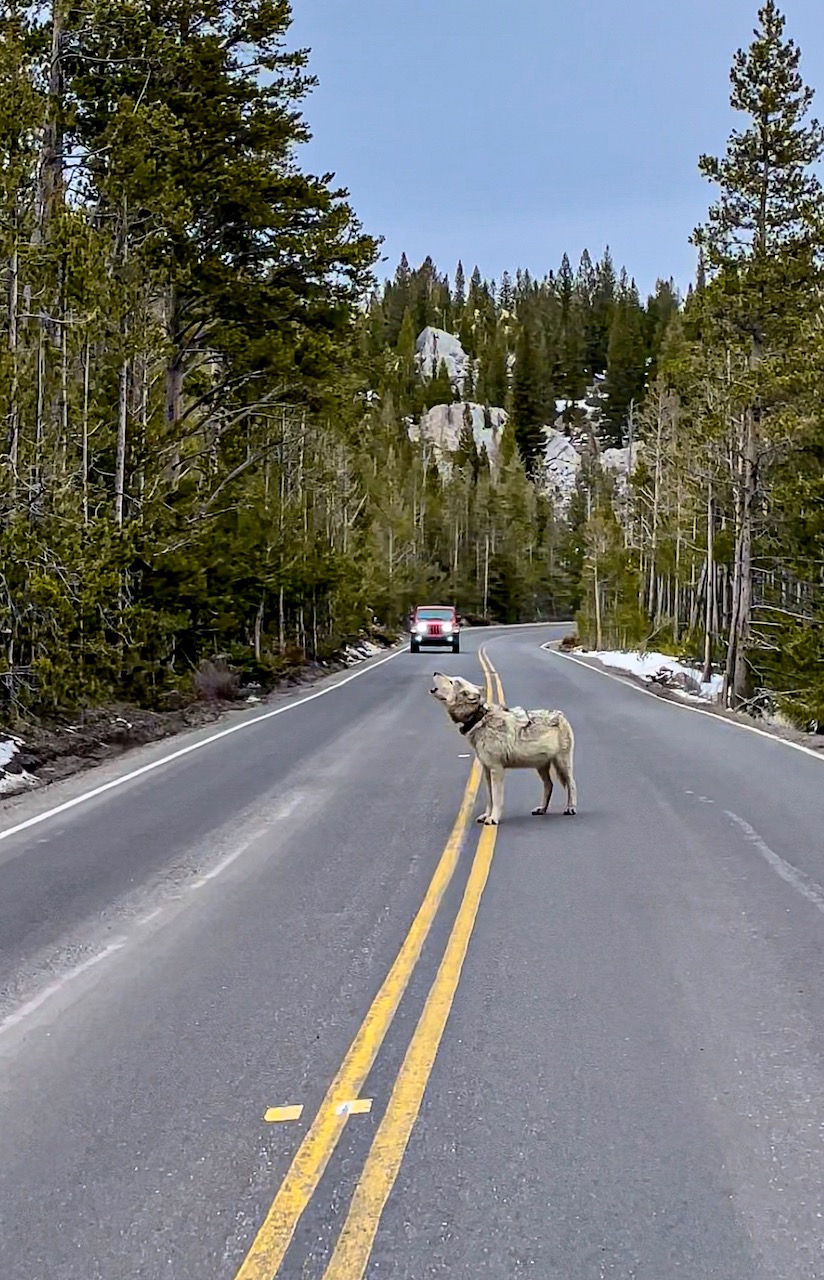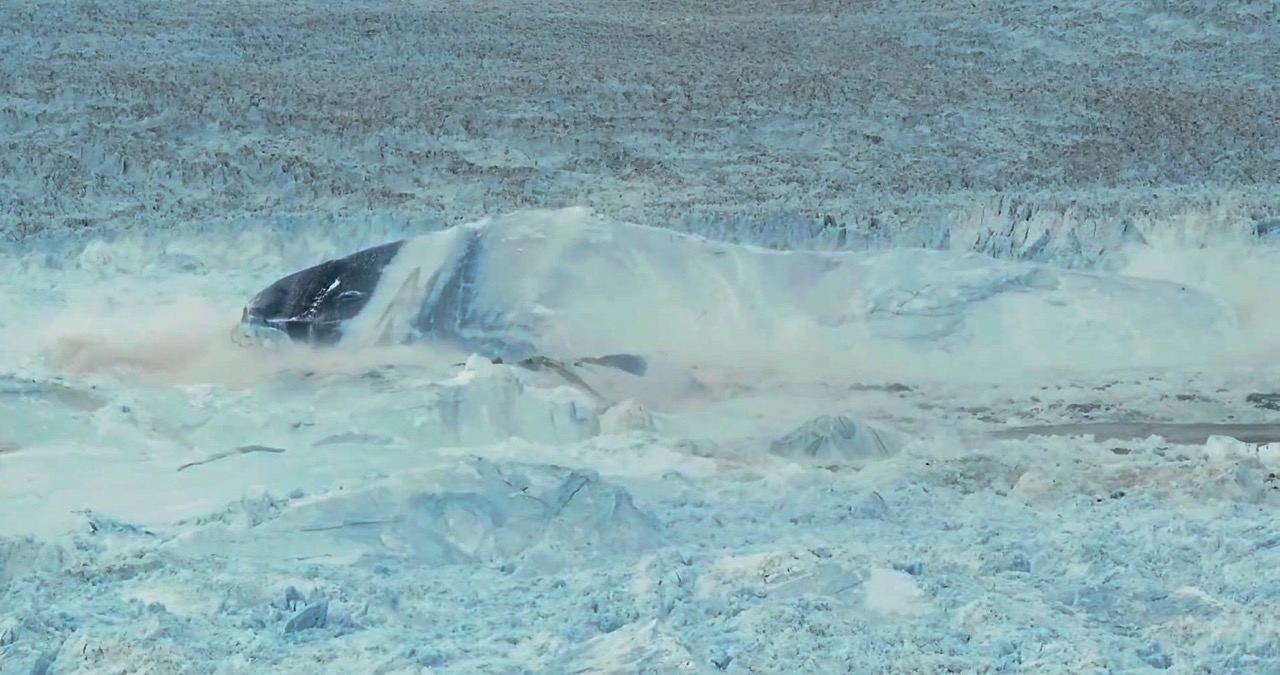It is officially the off season This Week in Yellowstone! In this post, I will talk about the drop in October visitation, how to make the most of one road being open in the park, where to see battling bighorn sheep, and even discuss the myth that bears hibernate. I even share a frozen waterfall location. This is a good one!
If you know someone heading to the park or going to Yellowstone this week, give this a read or a share and get ready to visit America’s first National Park. If you want to support this weekly park posts, please consider picking up a guidebook!
BIGGEST NEWS OF THE WEEK

October 2021 Visitation Down 12% Compared to October 2020
The streak of record breaking visitation to Yellowstone is over. In October of 2021, the park hosted 316,662 recreation visits. This number is down 12% from October 2020, which had 359,889 visits.
This time of the year, analyzing visitation data too thoroughly can be quite tricky. In a park press release, NPS officials also shared that recreation visits this October were up 85% from October 2019, which had 171,339 visits. This number is low because several short-term, weather-related road closures impacted visitation in 2019.
The park service also went on to say that Yellowstone’s road corridors and parking areas equate to less than 1,750 (0.079%) acres of the park’s 2.2 million acres. Most visitors stay within a half mile of these corridors.
The slowdown of visitation was very noticeable on my last visit to the park in late October. I had the entire Artist Point Overlook to myself, parking at Norris was 99% empty, and the trails were vacant of fellow hikers. Picnic areas once busy with eager adventurers were mostly silent, except for the sounds of wildlife nearby.
It is nice to see the park calm and mostly empty again, especially with the changing weather. Winter in the Rocky Mountains is not for everyone. With the interior roads now closed and the larger tourism areas taking a break for a couple of weeks, it will be interesting to see if November’s visitation numbers will see an increase or decrease compared with previous years. We shall see in a month!

November is Bighorn Sheep Mating Season
Have you ever wished you could see two bighorn sheep rams running full speed at each other and then crashing skull against skull? If you are heading to the park this week, you might just get to see it in person. While hard to see from the road, the bighorn sheep mating season this November will give you a great chance to see all sorts of cool activity. From large congregations of sheep on hillsides, to a few burly looking rams battling it out, this is a great time to visit.
While one of the best spots to watch this is found along a footpath near the confluence of the Lamar River and Soda Butte Creek, there are three places that may grab you access to see this incredible event. One of the most constant and time-tested locations is found on the cliffs between Mammoth Hot Springs and Gardiner, Montana. Stop at the pullouts along this stretch of road and scan the rocks. You have a high likelihood of seeing some bighorn sheep here. I have also seen rams battling along this section. I also recommend head to Lamar Valley and looking at the hillsides around the confluence of the aforementioned rivers. If you’d rather see them from a short hike, head up the closed road at Roosevelt and walk toward Tower Falls. I often see them on the opposite side of the canyon from the Calcite Springs Overlook.
Want more detail on the best tips and locations for wildlife sightings on your Yellowstone trip? I wrote a book for that very purpose! Pick up your digital ebook or paperback copy now!
WEATHER FOR THE COMING WEEK
This week’s weather is pretty normal for November. Highs will occasionally reach the 40s, and lows will drop to the teens at night. Snow will be falling off and on all week, with the larger snowfall totals occurring in the higher elevations toward Cooke City. Since the only roads open run between Gardiner, Montana and Cooke City, Montana, those are the two forecasts I will be sharing.
The full forecast is as follows:


This is the weather.com forecast for the two closest towns to the park that are currently open- Gardiner and Cooke City. While they don’t specifically cover the entire region, these forecasts give a great idea of what to expect all around the region As always, weather can and does change fast in the park, so always be prepared for anything.
WILDLIFE WATCH

Wildlife watching gets much easier now that the majority of park roads are closed. Instead of trying to cover hundreds of miles in a day to get to the well-known wildlife spots, you now have just over 50 miles of road to cover. Fortunately, the 50+ miles of open roads in Yellowstone right now are through some of the best wildlife watching spots in North America, if not the world.
The easiest way to spot wildlife like wolves and larger mammals is to keep your eyes open for cars at pullouts, large cameras and spotting scopes. A drive from Mammoth to Pebble Creek and back will give you the best chance at seeing all the wildlife.
While scanning and driving, be very aware of blind corners, as it is not uncommon to see wildlife on the roads. The more snow that slows down travel in the prairies and mountains, the more likely it is to see animals walking on the roads. This applies to elk, bison, coyotes, foxes, and deer, as well as the occasional bighorn sheep and wolf on the road. Go slow and know your car’s stopping distance in bad road conditions.
As I mentioned earlier, it is also now mating season for Bighorn Sheep. Males will be more aggressive and it is possible to see them battling each other. Your best chance at seeing this from the road will be west of the Soda Butte area in Lamar Valley and the section of road between Mammoth Hot Springs and Gardiner, Montana. Read the news section for more detailed locations.
Want more detail on the best tips and locations for wildlife sightings on your Yellowstone trip? I wrote a book for that very purpose! Pick up your digital ebook or paperback copy now!
ROADS AND CAMPGROUNDS

The only road open in Yellowstone right now is the route between the North Entrance in Gardiner, Montana and the Northeast Entrance near Cooke City Montana. This road will only close in the most serious of storms. However, snow and ice can remain on the 50+ miles of road all day, so drive with extreme caution. Snow plows will be running, but even after plowing, the road can still be treacherous. Be smart, do not speed, buckle up and don’t drive outside of your skill or experience level. Snow tires and chains are highly recommended.
For up-to-date information consult the map above, call (307) 344-2117 for recorded information, or sign up to receive Yellowstone road alerts on your mobile phone by texting “82190” to 888-777 (an automatic text reply will confirm receipt and provide instructions). Anticipate possible road closures due to inclement weather and dangerous driving conditions.
Planning on camping in the park this week? Mammoth is the only campground open in the park right now. Mammoth has not been filling up to capacity over the last week and this trend should continue until the busy season starts again in 2022. If you are hoping to camp in the cold, or planning far ahead, you can check the status of campgrounds in the park online here.
HIGHLIGHT OF THE WEEK

Head to Lost Creek Falls.
One of the easy side excursions on a cold day in the park is to check out Lost Creek Falls. Located in a sun starved canyon behind the Roosevelt Lodge buildings, Lost Creek Falls can be a winter wonderland. As temperatures continue to plunge, this waterfall freezes quickly, becoming an icy wonder hidden in the shadows and trees. The walk is pretty short, but takes some maneuvering to reach the trailhead. One of the easiest ways is to walk around the closed gates to the Roosevelt Lodge buildings and go behind the main lodge. You’ll see the trailhead and sign there. I am honestly not 100% sure how allowed this route to the trailhead is, but I have never been talked to when going there. You can also reach the trailhead by walking past the ranger station just west of the bathroom area along the main road. Here, you’ll want to walk until the trail, turning left to reach the path to the waterfall.
The path to the falls is short, but does climb a little. It can and will be snowy and icy, so have the right traction devices for your shoes. You will also want a few extra layers for this, as the temperature in this canyon is easily 10-15 degrees colder than at the parking area.
Once at the falls, the experience can vary. In deep snow, you can walk closer to the base of the falls. Reaching the base of the falls is not an easy jaunt, so only proceed past the end of trail sign if you have winter off-trail experience. Occasionally, ice climbers will be scaling the frozen falls, which can be seen from the end of the trail sign.
TIP OF THE WEEK

Continue to be bear aware this winter. They aren’t sleeping through the whole thing.
There is a common misconception that bears hibernate over the winter. The truth is they enter a state of torpor, not hibernation. Hibernation is for smaller animals, with the largest in the region that hibernates being the marmot. During hibernation, animals lower their body temperature, slow their heart rate and breathing.
Torpor is different. It is just a deeper level of sleep. During torpor, the animals are able to wake up quickly if needed. Occasionally, bears will leave their den if the scent of food is nearby, as every calorie counts toward surviving the brutal winters. They also can wake up quickly to avoid potential danger.
Torpor is similar to hibernation, but not quite as extreme. Bears will have decreased breathing and heart rates during torpor, but their body temperature only reduces slightly.Waking expends energy and involves violent shaking and muscle contractions, much like shivering. The energy lost is offset by how much energy is saved in the torpid state. Females bears awaken from torpor to give birth.
Despite the fact that they do not truly hibernate, the chances of encountering a bear over winter are very low. According to the National Forest Foundation, bears can sleep more than 100 days without eating, drinking, or passing waste! Bears can also turn their pee into protein. The more you know!
For a much longer article on this topic, check out this piece from the National Forest Foundation.
WANT TO KNOW MORE?
Curious about something not mentioned in the post?
Send me an email or message on social media and let me know how I can help.



